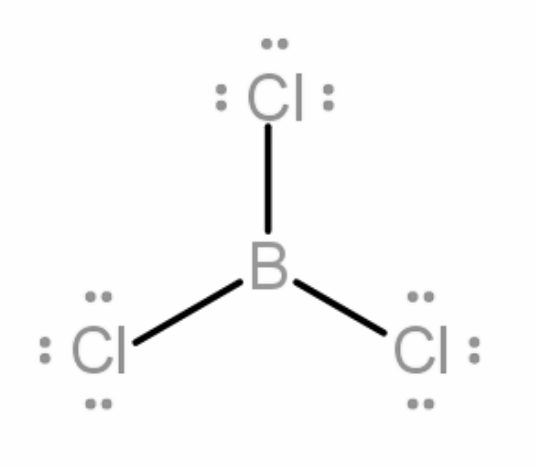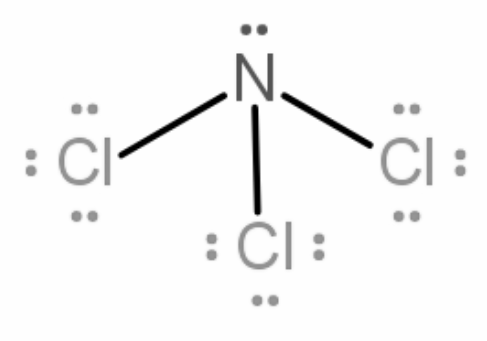
The \[BC{{l}_{3}}\] is planar molecule, whereas \[NC{{l}_{3}}\] is a pyramidal because:
a.) N — Cl bond more covalent bond than B — Cl bond.
b.) B — Cl bond is more polar than N — Cl bond.
c.) nitrogen atom is similar to boron atom.
d.) \[BC{{l}_{3}}\] has no lone pair but \[NC{{l}_{3}}\] has a lone pair or electrons.
Answer
490.2k+ views
Hint: Molecular geometry is the three-dimensional arrangement of a molecule constituting the general shape as well as the bond length, bond angle and other geometrical parameters that is useful for determining the position of each atom.
Complete step by step solution:
According to the valence shell electron pair repulsion theory (VSEPR), molecules try to attain a geometry that minimizes the repulsion between electrons in the valence shell of the atom.
The valence shell is taken as a sphere and with electrons localizing on the spherical surface at maximum distance from one another.
Now given in the question \[BC{{l}_{3}}\] is a planar molecule, we know that boron has 3 valence electrons, it will form a covalent bond with each of the chlorine atoms. Therefore, 3 bond pairs will be formed. There will be no lone pairs as all the valence electrons of boron will make a bond with the 3 chlorine atoms.
Now the molecule will try to attain a geometry that minimizes the repulsion between the bond pair - bond pair, forming an angle of 120 degree between all the bonds.
On arranging all the bond pairs \[BC{{l}_{3}}\] forms a trigonal planar shape.

Similarly, in \[NC{{l}_{3}}\], Nitrogen has 5 valence electrons, it will form a covalent bond with each of the chlorine atoms. Therefore, 3 bond pairs will be formed. There will be one lone pair left as only 3 of the 5 valence electrons are used in bond formation.
Now the molecule will try to attain a geometry that minimizes the repulsion between the bond pair - lone pair, forming an angle of 109.5 degree between all the bonds.
On arranging all the bond pairs \[NC{{l}_{3}}\] forms a pyramidal shape.

Therefore, we can conclude that the \[BC{{l}_{3}}\] is planar because it has no lone pairs and \[NC{{l}_{3}}\] is pyramidal as it has one lone pair of electrons. So, the correct option is (d).
Note: Geometry of a molecule is the arrangement of (lone pair + bond pair) around the central atom and it corresponds to the coordination number of the molecule while shape is the structure of the molecule excluding the lone pair on the central atom. Lone pairs are not considered when we determine the shape of the molecules.
Complete step by step solution:
According to the valence shell electron pair repulsion theory (VSEPR), molecules try to attain a geometry that minimizes the repulsion between electrons in the valence shell of the atom.
The valence shell is taken as a sphere and with electrons localizing on the spherical surface at maximum distance from one another.
Now given in the question \[BC{{l}_{3}}\] is a planar molecule, we know that boron has 3 valence electrons, it will form a covalent bond with each of the chlorine atoms. Therefore, 3 bond pairs will be formed. There will be no lone pairs as all the valence electrons of boron will make a bond with the 3 chlorine atoms.
Now the molecule will try to attain a geometry that minimizes the repulsion between the bond pair - bond pair, forming an angle of 120 degree between all the bonds.
On arranging all the bond pairs \[BC{{l}_{3}}\] forms a trigonal planar shape.

Similarly, in \[NC{{l}_{3}}\], Nitrogen has 5 valence electrons, it will form a covalent bond with each of the chlorine atoms. Therefore, 3 bond pairs will be formed. There will be one lone pair left as only 3 of the 5 valence electrons are used in bond formation.
Now the molecule will try to attain a geometry that minimizes the repulsion between the bond pair - lone pair, forming an angle of 109.5 degree between all the bonds.
On arranging all the bond pairs \[NC{{l}_{3}}\] forms a pyramidal shape.

Therefore, we can conclude that the \[BC{{l}_{3}}\] is planar because it has no lone pairs and \[NC{{l}_{3}}\] is pyramidal as it has one lone pair of electrons. So, the correct option is (d).
Note: Geometry of a molecule is the arrangement of (lone pair + bond pair) around the central atom and it corresponds to the coordination number of the molecule while shape is the structure of the molecule excluding the lone pair on the central atom. Lone pairs are not considered when we determine the shape of the molecules.
Recently Updated Pages
Master Class 11 Accountancy: Engaging Questions & Answers for Success

Glucose when reduced with HI and red Phosphorus gives class 11 chemistry CBSE

The highest possible oxidation states of Uranium and class 11 chemistry CBSE

Find the value of x if the mode of the following data class 11 maths CBSE

Which of the following can be used in the Friedel Crafts class 11 chemistry CBSE

A sphere of mass 40 kg is attracted by a second sphere class 11 physics CBSE

Trending doubts
10 examples of friction in our daily life

Difference Between Prokaryotic Cells and Eukaryotic Cells

State and prove Bernoullis theorem class 11 physics CBSE

What organs are located on the left side of your body class 11 biology CBSE

Define least count of vernier callipers How do you class 11 physics CBSE

The combining capacity of an element is known as i class 11 chemistry CBSE




